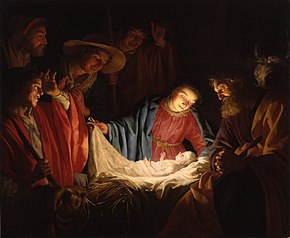|
The Rocking Carol
"The Rocking Carol",[1] also known as "Little Jesus, Sweetly Sleep"[2] and "Rocking",[3] is an English Christmas carol by Percy Dearmer. It was translated from Czech ("Hajej, nynej, Ježíšku")[4] in 1928 and is performed as a lullaby to the baby Jesus. History The carol was first published in an anthology in 1920 in Czechoslovakia, where it was described as a traditional Czech carol.[1] It was loosely translated into English by Percy Dearmer,[1] as part of his effort of resurrecting hymns that had fallen into disuse and introducing European hymns into the Church of England.[1][self-published source] The carol is sung in the form of a lullaby to Jesus while rocking the manger as if it were a more modern cradle,[5] as noted by the repetitive chorus of "We will rock you".[6][7] It was first published in The Oxford Book of Carols, which Dearmer had edited alongside Martin Shaw and Ralph Vaughan Williams, in 1928.[1] After initial publication, the carol gradually decreased in popularity until the 1960s when the English actress Julie Andrews performed a commercially released version of it.[8] Following this, it was published in Carols for Choirs by Reginald Jacques and David Willcocks.[9] Description"The Rocking Carol" consists of two verses with eight lines each.[10] It is performed with a 10.7.8.8.7.7 metre.[2] The hymn continues to be published within Church of England and Anglican hymnals.[7] The hymn has been described as the quintessential lullaby carol compared with similar wording lullaby Christmas carols of "Silent Night" and "Away in a Manger" as hymnologists opine that the lyrics and melody both strongly suggest the rocking of a cradle.[5][needs copy edit] Melody and wordsThe original Czech word are: 1. Hajej, nynej, Ježíšku, 2. Hajej, nynej, miláčku, The English words are a poetic translation.
CriticismAfter publication, the final line of the carol met with dissatisfaction, with a number of hymnal editors altering it from "Darling, darling little man" to "Son of God and Son of Man".[1] Barry Cooper has argued that it has only minor biblical references and is written without theological content and "painting a wholly imaginary scene".[12] References
External links |
||||||||||||
![\header { tagline = ##f }
\layout { indent = 0 \set Score.tempoHideNote = ##t
\context { \Score \remove "Bar_number_engraver" }
\context { \Voice \remove "Dynamic_engraver" }
}
global = { \key f \major \time 2/4 \autoBeamOff }
soprano = \relative c' { \global \set Staff.midiPanPosition = -0.5 \set midiInstrument = "recorder"
f8\mf a c c | d d16 ([b]) c4 | d8\pp d16 ([b]) c4 |
bes8\mf bes16 ([g]) a8 a16 ([f]) | g8 g16 ([e]) f4 |
a8 c bes a | g a g c, |
a'\pp c bes a | g a g c, |
f8\mf a c c | d d16 ([b]) c4 |
bes!8\pp bes16 ([g]) a8 \tempo 4 = 36 a16 ([f]) | g8 g16 ([e]) f4 \bar "|."
}
alto = \relative c' { \global \set Staff.midiPanPosition = 0.5 \set midiInstrument = "flute"
f8\mf a f a | g g g4 | g8\pp g g4 |
f8\mf d e c | d c c4 |
f8 f f f | e d e c |
f\pp f f f | f f e c |
f8\mf a f a | g g g4 |
f8\pp d e c | d c c4 \bar "|."
}
tenor = \relative c' { \global \set Staff.midiPanPosition = -1 \set midiInstrument = "oboe"
a8\mf c a c | b b16 ([d]) c4 | b!8\pp b16 ([d]) c4 |
d8\mf bes c a | bes g a4 |
c8 a bes c | c a c c |
c\pp a bes c | d d g, c |
a8\mf c a c | b b16 ([d]) c4 |
d8\pp bes c e | bes g a4 \bar "|."
}
bass = \relative c { \global \set Staff.midiPanPosition = 1 \set midiInstrument = "bassoon"
f8 f f f | f g e4 | f8 g e4 |
d8 g c, f | bes, c f,4 |
f'8 f d f | c f c c |
es f d c | b b c c |
f8 f f f | f g e4 |
d8 g c, f | bes, c f,4 \bar "|."
}
verseOne = \lyricmode { \set stanza = "1."
Lit -- tle Je -- sus, sweet -- ly sleep, do not stir;
we will lend a coat of fur.
We will rock you, rock you, rock you,
we will rock you, rock you, rock you.
See the fur to keep you warm,
snug -- ly round your ti -- ny form. }
verseTwo = \lyricmode { \set stanza = "2."
Ma -- ry's lit -- tle ba -- by, sleep, sweet -- ly sleep,
Sleep in com -- fort, slum -- ber deep.
\repeat unfold 16 { \skip 1 }
We will serve you all we can,
dar -- ling, dar -- ling lit -- tle man.
}
\score {
\new ChoirStaff <<
\new Staff
<<
\new Voice = "soprano" { \voiceOne \soprano }
\new Voice = "alto" { \voiceTwo \alto }
>>
\new Lyrics \lyricsto "soprano" \verseOne
\new Lyrics \lyricsto "soprano" \verseTwo
\new Staff
<<
\clef bass
\new Voice = "tenor" { \voiceOne \tenor }
\new Voice = "bass" { \voiceTwo \bass }
>>
>>
\layout { }
}
\score { << \soprano \\ \alto \\ \tenor \\ \bass >>
\midi {
\tempo 4=42
\context { \Score midiChannelMapping = #'instrument }
\context { \Staff \remove "Staff_performer" }
\context { \Voice \consists "Staff_performer" }
}
}](http://upload.wikimedia.org/score/s/3/s3g4md4ug1qshgdduamo51amsa4qzuo/s3g4md4u.png)